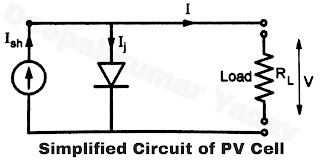Performance of PV Cell (Current -Voltage Characteristics)
A solar cell is generally uses p-n junction. The performance of a solar cell is represented by a plot of its current (ISC) and voltage (VOC) shown in Figure A.
 |
| Figure A |
It could be observed that the current initially remains constant with the increase in voltage and then the current rapidly drops to zero. In this the intercept on Y-axis, ISC is called the short circuit current and the intercept on the X-axis, VOC is called open circuit voltage. Corresponding amount of power delivered by the cell is also shown in Figure A. Point A represents the point of maximum power delivered by the cell. Lm and Vm represent the current and voltage respectively at which the maximum power is delivered by the cell. Then we define a term called fill factor, FF as the ratio of (Im. Vm / ISC . VOC). The value of fill factor lies between 0 to 1.
An equivalent circuit for P.V. cell is shown in Figure B. Such a circuit helps to analyse the performance of the cell in this
ISC = Supply current from source i.c. light generated current
Rsh = Internal shunt resistance
Rs = Internal series resistance. It is due to high sheet resistance of diffused layer.
Ij = Junction current at p-n junction
1 = Current passing through the load having resistance RL
V = Voltage drop across the load.
 |
| Figure B |
 |
| Figure C |
Since the internal series resistance (Rs) is negligible compared to load resistance RL due to load, the power loss in series resistance can be neglected. Usually the shunt resistance Rsh is much higher than the load resistance, RL. Therefore the current 1 is negligible and most of the current passes through the load. Taking into account these factors, a simplified circuit for PV cell is shown in Figure C.
The current and voltage relationship is given by the equation,
Ij = Io [Exp (eV / kT) -1] where
Io = Saturation current called as dark current. It is obtained when a large negative voltage is applied across the diode.
V = Voltage across junction
e = electron charge = 1.602 x 10-19 J/V
k = Boltzmann’s constant = 1.381 X 10-23 J/K
T = Temperature in Kelvin
I = ISC – Io [Exp . (eV/kT ) – 1]
Solar Cell Efficiency : From the point of view of energy conversion solar cell is a device which converts the optical energy to electrical energy. Hence the efficiency of a solar cell can be defined as :
Efficiency Maximum power output / Incident Intensity x Area of the device exposed
η = Insolation x Area ….(I)
where,
Vm = Cell Voltage
Im= Current
This could be written as
η = FF x VOC x ISC / Total insolation ….(II)
where,
FF is called the fill factor
VOC = Open circuit voltage
ISC = Short circuit current.
Quantum Emiciency, QE
QE = Number of electron hole pairs generated per unit area / Number of photons striking the device …(III)
Spectral responsivity, SR
SR = (Electron flux) / (hc/ SK – (Photon energy) ….(IV)
SR = q λ / h c ….(V)
